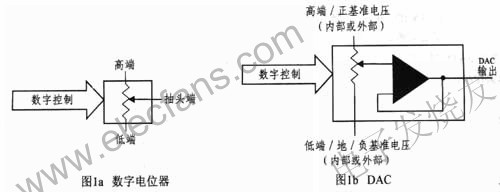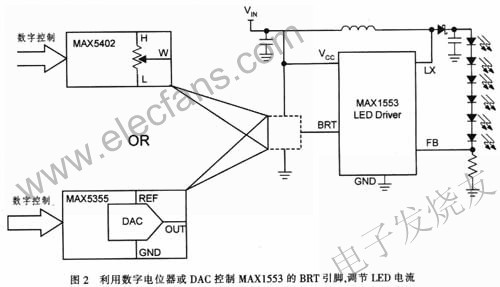1 Introduction
There are two options for fine-tuning analog outputs using digital input control: potentiometers">Digital potentiometers and digital-to-analog converters (DACs), both of which use digital inputs to control analog outputs. Digital potentiometers can adjust analog voltages; DACs can adjust currents or voltages. Potentiometers have three analog connections: a high end, a wiper (or analog output), and a low end (see Figure 1a). DACs have corresponding three terminals: a high end corresponds to a positive reference voltage, a wiper corresponds to the DAC output, and a low end may correspond to ground or a negative reference voltage (see Figure 1b).

There are some significant differences between DACs and digital potentiometers, the most obvious of which is that DACs typically include an output amplifier/buffer, while digital potentiometers do not. Most digital potentiometers require an external buffer to drive low-impedance loads. In some applications, users can easily choose between DACs and digital potentiometers; in other applications, both can meet the needs. This article compares DACs and digital potentiometers to help users make the most appropriate choice.
2 D/A converter
DACs usually use a resistor string structure or an R-2R ladder architecture. When using a resistor string, the DAC input controls a set of switches that divide the reference voltage through a series of matched resistors. For the R-2R ladder architecture, the positive reference voltage is divided by switching each resistor to generate a controlled current. This current is sent to the output amplifier, and the voltage output DAC converts this current into a voltage output. The current output DAC outputs the R-2R ladder current after buffering the amplifier. If you choose a DAC, you must also consider specific indicators, such as serial/parallel port, resolution, number of input channels, current/voltage output, cost, etc. For systems that focus on speed, you can choose a parallel interface; if you focus on cost and size, you can choose a 3-wire or 2-wire serial port. This device has fewer pins and can significantly reduce costs. In addition, some 3-wire interfaces can reach a communication rate of 26 MHz, and 2-wire interfaces can reach a rate of 3.4 MHz. Another indicator of DAC is resolution. 16-bit or 18-bit DACs can provide microvolt control. For example, an 18-bit, 2.5V reference DAC has each LSB corresponding to 9.54μV. High resolution is extremely important for industrial control products (such as robots and engines). Currently, the highest resolution that digital potentiometers can provide is 10 bits or 1,024 taps. Another advantage of digital/analog converters is the ability to integrate multiple converters on a single chip. For example, the MAX5733 has 32 built-in DACs, each of which can provide 16 bits of resolution. Current digital potentiometers can only provide a maximum of 6 channels, such as the DS3930.
DACs can source or sink current, giving designers greater flexibility. For example, the MAX5550 10-bit DAC can provide up to 30mA of output drive through an internal amplifier, P-channel MOSFET, and pull-up resistor. The MAX5547 10-bit DAC combines an amplifier, N-channel MOSFET, and pull-down resistor to provide 3.6 mA of sink current. In addition to current output, some DACs can also be connected to external amplifiers to provide additional output control. Because digital-to-analog converters usually have built-in amplifiers, they cost more than digital potentiometers. But as new DACs shrink in size, the cost difference is getting smaller.
3 Digital Potentiometer
As mentioned above, digital potentiometers can control resistance through digital inputs. The 3-terminal digital potentiometer in Figure 1a is actually an adjustable resistor divider with fixed end-to-end resistance. By connecting the center tap of the potentiometer to the high or low end, or leaving the high or low end floating, the digital potentiometer can be configured as a 2-terminal variable resistor. Unlike digital/analog converters, digital potentiometers can connect the H end to the highest voltage or the lowest voltage end. When selecting a digital potentiometer, users also need to consider specific indicators: linear or logarithmic adjustment, number of taps, number of tap levels, non-volatile memory, cost, etc. The control interfaces include increment/decrement, button, SPI and I2C.
Like the D/A converter, the digital potentiometer communicates via serial ports, including I2C and SPI. In addition, the digital potentiometer also provides a 2-wire increment and decrement interface control. Generally, the significant difference between a DAC and a digital potentiometer is that the D/A converter has an internal output amplifier. This output amplifier can drive low-impedance loads.
4 DAC/potentiometer selection
In many applications, users can easily choose between DAC and potentiometer. Motor control, sensor or robotic systems that require high resolution need to use DAC. In addition, high-speed applications such as base stations and instruments require high speed and resolution, and even require DAC with parallel interface. The linear characteristics of the potentiometer facilitate the implementation of the amplifier feedback network. Compared with the digital/analog converter, the logarithmic potentiometer is more suitable for volume adjustment.
However, in many current applications, the boundary between DAC and digital potentiometer is blurred. Both the DAC and digital potentiometer in Figure 2 can be used to control the MAX1553 LED driver. The DC voltage at the MAXll53 brightness (BRT) input and the current-sense resistor determine the LED current.

Previous article:What is the difference between ADC and DAC?
Next article:Single circuit meets system resolution and 12-bit accuracy requirements
- High signal-to-noise ratio MEMS microphone drives artificial intelligence interaction
- Advantages of using a differential-to-single-ended RF amplifier in a transmit signal chain design
- ON Semiconductor CEO Appears at Munich Electronica Show and Launches Treo Platform
- ON Semiconductor Launches Industry-Leading Analog and Mixed-Signal Platform
- Analog Devices ADAQ7767-1 μModule DAQ Solution for Rapid Development of Precision Data Acquisition Systems Now Available at Mouser
- Domestic high-precision, high-speed ADC chips are on the rise
- Microcontrollers that combine Hi-Fi, intelligence and USB multi-channel features – ushering in a new era of digital audio
- Using capacitive PGA, Naxin Micro launches high-precision multi-channel 24/16-bit Δ-Σ ADC
- Fully Differential Amplifier Provides High Voltage, Low Noise Signals for Precision Data Acquisition Signal Chain
- Innolux's intelligent steer-by-wire solution makes cars smarter and safer
- 8051 MCU - Parity Check
- How to efficiently balance the sensitivity of tactile sensing interfaces
- What should I do if the servo motor shakes? What causes the servo motor to shake quickly?
- 【Brushless Motor】Analysis of three-phase BLDC motor and sharing of two popular development boards
- Midea Industrial Technology's subsidiaries Clou Electronics and Hekang New Energy jointly appeared at the Munich Battery Energy Storage Exhibition and Solar Energy Exhibition
- Guoxin Sichen | Application of ferroelectric memory PB85RS2MC in power battery management, with a capacity of 2M
- Analysis of common faults of frequency converter
- In a head-on competition with Qualcomm, what kind of cockpit products has Intel come up with?
- Dalian Rongke's all-vanadium liquid flow battery energy storage equipment industrialization project has entered the sprint stage before production
- Allegro MicroSystems Introduces Advanced Magnetic and Inductive Position Sensing Solutions at Electronica 2024
- Car key in the left hand, liveness detection radar in the right hand, UWB is imperative for cars!
- After a decade of rapid development, domestic CIS has entered the market
- Aegis Dagger Battery + Thor EM-i Super Hybrid, Geely New Energy has thrown out two "king bombs"
- A brief discussion on functional safety - fault, error, and failure
- In the smart car 2.0 cycle, these core industry chains are facing major opportunities!
- The United States and Japan are developing new batteries. CATL faces challenges? How should China's new energy battery industry respond?
- Murata launches high-precision 6-axis inertial sensor for automobiles
- Ford patents pre-charge alarm to help save costs and respond to emergencies
- New real-time microcontroller system from Texas Instruments enables smarter processing in automotive and industrial applications
- SDIO connection to TF card initialization failed
- This Wednesday's award-winning live broadcast: 5G conformance testing and device acceptance testing
- Is it "reasonable..." to fly a kite made of your own photo?
- Why is the application of gallium nitride in RF electronics still so popular?
- When the MOS is turned on like 2301, is the VDS voltage 0? That is, there is no loss? The simulation shows that there is no loss.
- Battery Management System BMS Technical Data Transfer
- 【Running posture training shoes】No.004-Sensor production and primary data processing
- What is the principle of the pull-up resistor of the P0 port of the 51 single-chip microcomputer?
- X-NUCLEO-IKS01A3 sensor test based on STM32F401RE development board 2 LPS22HH pressure sensor
- 【FAQ】Enabling secure authentication with TrustFlex secure elements and Microsoft Azure | Microchip Seminar

 Signal Integrity and Power Integrity Analysis (Eric Bogatin)
Signal Integrity and Power Integrity Analysis (Eric Bogatin) PFC Reference Design and Source Code
PFC Reference Design and Source Code
















 京公网安备 11010802033920号
京公网安备 11010802033920号